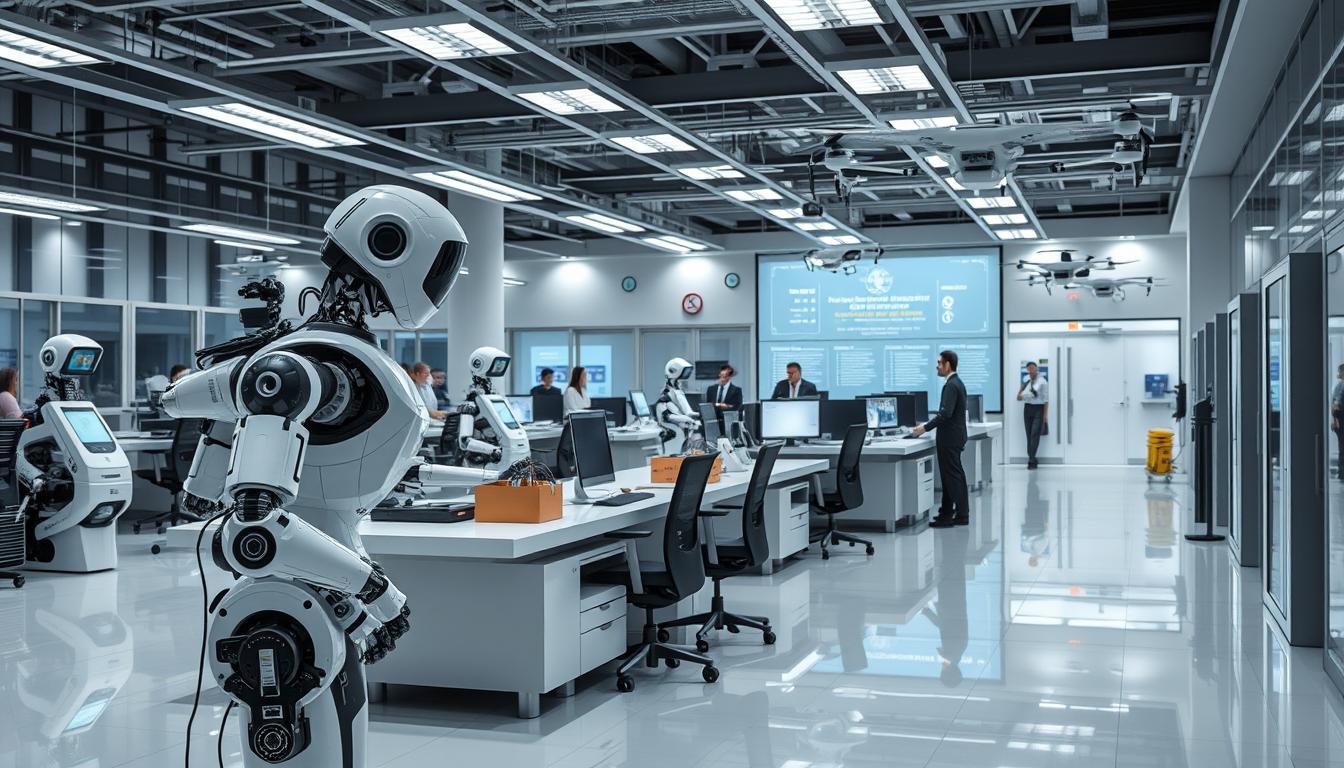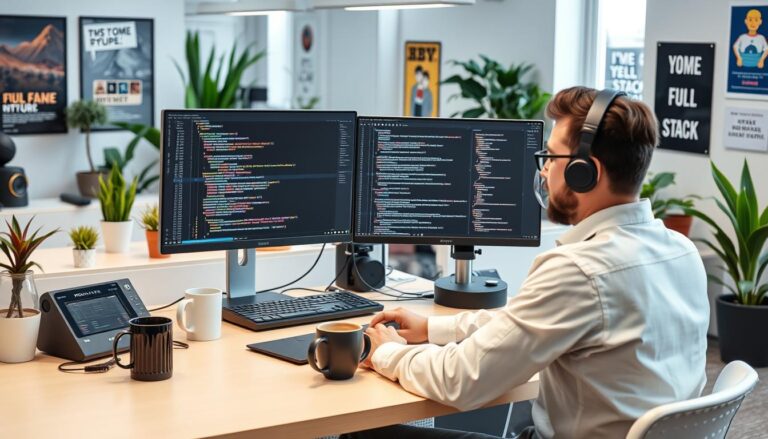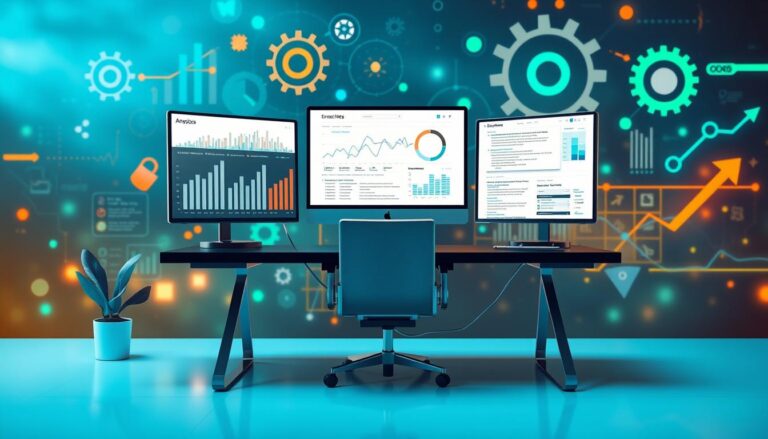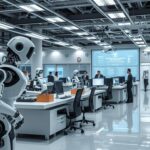Technology is changing the job market fast. A recent McKinsey report says up to 30% of work hours in the US could be automated by 2030. This shows how big the impact of AI on work could be.
Jobs like data entry, telemarketing, and assembly line work are likely to be taken over by AI and robots soon. Even jobs that need technical skills, like analyzing medical scans, could be automated. Sadly, 400 to 800 million people might lose their jobs to AI by 2030.
A futuristic office scene depicting various automated machines and robots performing tasks traditionally done by humans, such as a robotic assembly line, an AI-powered customer service station, and drones delivering packages, all set in a sleek, high-tech environment with bright lighting and modern design elements.
Key Takeaways
- Up to 30% of hours worked in the US could be automated by AI by 2030
- Many low-skill, repetitive jobs are at high risk of being replaced by AI and robots
- Even technical jobs like medical diagnosis are susceptible to AI automation
- An expected 400 to 800 million people will lose their jobs due to AI by 2030
- AI is poised to have a significant impact on the future of work and employment
Table of Contents
AI’s Impact on the Job Market
Artificial intelligence (AI) is changing the job market fast. Studies show AI is reshaping work. A July 2023 report by McKinsey says up to 30 percent of US jobs could be automated by 2030.
Recent Studies on Job Automation
AI adoption is speeding up. A PwC study found 52% of companies sped up their AI plans because of the pandemic. By 2021, 86% saw AI as key to their business.
Frito-Lay’s digital shift is a great example. They made five years of progress in just 18 months.
Factors Driving AI Adoption in the Workforce
More investment in AI means new jobs for skilled people. It’s changing work to focus more on STEM and IT. AI is creating new companies and boosting demand for data and tech talent.
Companies using AI are looking for more educated workers. This is making work structures more flat.
| Sector | AI Adoption Rate |
|---|---|
| Marketing and Advertising | 37% |
| Technology | 35% |
| IT Professionals | 54% |
| Data Engineers | 35% |
| Developers and Data Scientists | 29% |
| Security Professionals | 26% |
| Customer Service Staff | 25% |
AI may change some jobs, but it also opens new doors. As work evolves, understanding AI’s role is key to the future.
Jobs at High Risk of AI Replacement
Artificial intelligence (AI) is changing the job market fast. It’s expected to replace 2.4 million US jobs by 2030. Jobs at risk are those with tasks that AI can easily do, like repetitive or rule-based tasks.
Occupations Vulnerable to Automation
Jobs like data entry clerks, telemarketers, cashiers, and customer service reps are at risk. AI can now understand speech and text better, making these jobs less needed. Even jobs needing a college degree, like radiology, might see AI tools reduce the need for certain roles.
Skills and Tasks Targeted for AI Takeover
AI is great at processing data, analyzing, and making routine decisions. Jobs at high risk of AI replacement often involve repetitive, rule-based activities that can be easily automated. This includes roles in manufacturing, retail, finance, and more, where AI can make things more efficient and cost-effective. But, jobs needing creativity, emotional intelligence, and complex problem-solving are safer from AI takeover.
| Education Level | Median AI Task Automation Potential |
|---|---|
| High school diploma or less | 6% of tasks potentially aided by AI |
| High school diploma | 17% of tasks potentially aided by AI |
| Vocational or 2-year degree | 38% of tasks potentially aided by AI |
| Four-year degree | 75% of tasks potentially aided by AI |
| Graduate school | 64% of tasks potentially aided by AI |
While AI might replace some jobs, it also brings new chances and growth. By learning new skills and adapting, you can thrive in the changing job market
Transportation and Logistics Jobs Replaced by AI
The transportation and logistics industry is facing big changes with AI. Reports say nearly 50% of jobs in transportation and over 5% of warehouse jobs could be replaced by 2030.
Drivers, whether in taxis, trucks, or delivery vans, are at risk. Self-driving tech is getting better fast. Companies are testing autonomous vehicles on roads today. AI predictive tools, like Google’s, help predict what people want, helping companies manage their stock better.
Warehouse workers are also at risk as robots take over. Robots are already helping in some warehouses. They help with picking, sorting, and moving items, making things faster and cheaper.
While AI might cut some jobs, it also creates new ones. These new jobs need special skills like tech know-how and science smarts. People with these skills will be in demand as AI keeps getting better.
“Although AI adoption may lead to a decrease in certain job roles within the industry, it also opens up new employment opportunities, allowing human workers to focus on safer and more fulfilling tasks while allowing AI to handle repetitive or hazardous jobs.”
As the industry changes with AI, companies and workers need to adapt. This is key to doing well in the future.
Food Service and Retail Roles Disrupted by AI
AI is changing the job market a lot, especially in food service and retail. Studies say AI and automation could replace millions of jobs in these areas in the next ten years.
Automation in Fast Food and Restaurants
The food service industry is a big target for AI. A Statista report says the global food automation and robotics market will grow a lot by 2030. AI is already helping in food prep, like following recipes and monitoring cooking.
Self-service kiosks are also making cashiers less needed. Customers can order without help. This trend is expected to grow, with McKinsey Global Institute saying 80% of restaurant jobs could be taken by robots.
Jobs like servers and counter workers are at risk. AI and automation could replace 51% and 57% of these roles, respectively.
Impact on Retail Salespeople and Cashiers
The retail industry is also changing fast with AI and e-commerce. The McKinsey study predicts a big drop in jobs for retail salespeople and cashiers. Automated checkout systems and AI product recommendations are making in-store staff less necessary.
Virtual and augmented reality in online shopping is changing retail too. Customers can shop digitally from home, making in-store visits less common.
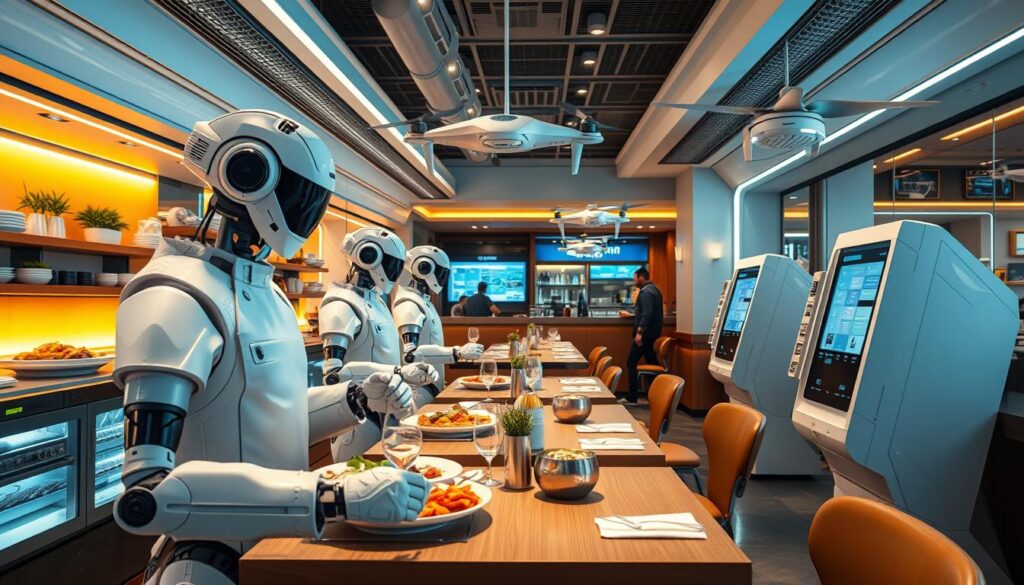
A futuristic restaurant scene showcasing robotic chefs preparing gourmet meals, automated kiosks taking orders at sleek digital interfaces, and drones delivering food to tables, all set in a modern, vibrant space with an emphasis on technology and efficiency.
Office and Admin Support Roles Threatened by AI
Artificial intelligence (AI) is changing the job market, affecting office and admin roles. Secretaries, administrative assistants, and clerks do tasks that AI can now do. These tasks are repetitive and routine, making them prime targets for AI.
AI for Scheduling, Data Entry, and Administrative Tasks
AI is taking over jobs like scheduling, filing, and data entry. Companies are using AI for meeting schedules, travel plans, and expense reports. Customer service is also at risk as AI chatbots and voice assistants improve.
Studies show up to 14% of admin jobs could be automated by 2030. Business leaders plan to use AI for admin tasks, with 69% aiming to automate.
Tools like IBM Watson and OpenAI GPT are making admin tasks easier. They offer natural language processing and machine learning. Software like Google Travel and Microsoft 365 Transcription also help reduce manual work.
As AI takes over admin jobs, workers need to keep up with ai job automation and ai takeover of jobs. Skills like empathy, problem-solving, and communication are still key. These skills will help workers adapt to an AI-driven world.
Sales and Marketing Jobs Replaced by AI
AI is changing the game in sales and marketing. It can predict what users will do next and suggest the best responses. This helps salespeople have better conversations and gives them useful information.
AI tools also automate tasks like scoring leads and personalizing messages. This makes sales teams work more efficiently.
Virtual agents and chatbots are starting to take over simple sales tasks. They can answer basic questions, qualify leads, and guide prospects through automated campaigns. This reduces the need for human salespeople in some cases.
AI Sales Tools and Virtual Agents
The rise of e-commerce and self-service options has also reduced the need for traditional salespeople. Customers like to buy things on their own, especially for simple or low-cost items. This means fewer sales jobs.
But, for complex sales, human salespeople are still essential. They handle strategy, consulting, and building relationships. AI will help support and improve the sales process, not replace it.
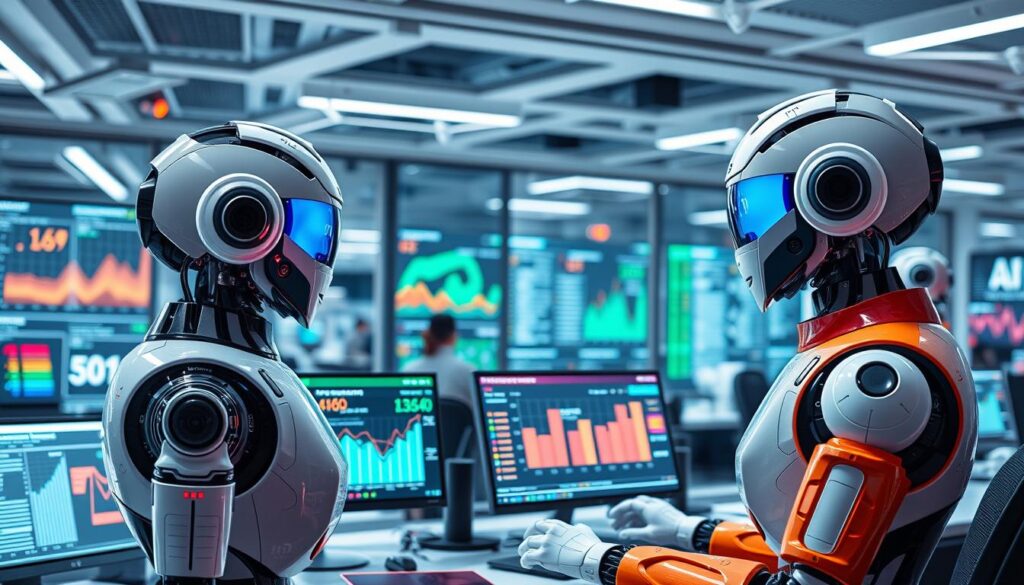
A futuristic office environment showcasing robots and AI systems seamlessly managing sales and marketing tasks, automated dashboards displaying data analytics, advanced algorithms at work, digital assistants interacting with clients via screens, vibrant colors highlighting the integration of technology and human-like interfaces, a sleek and modern design emphasizing efficiency and innovation.
| Job Role | Likelihood of Automation |
|---|---|
| Telemarketing | 99-100% |
| Bookkeeping Clerks | 99-100% |
| Compensation and Benefits Managers | 96-41% |
| Receptionists | 96-93% |
| Couriers | 94-95% |
| Proofreaders | 84-100% |
| Computer Support Specialists | 65-52% |
| Market Research Analysts | 61-40% |
| Advertising Salespeople | 54-52% |
AI is changing sales and marketing, but it’s not taking over everything. While AI tools and virtual agents will replace some jobs, human skills are still key. Building relationships and providing expertise are things only humans can do.
jobs replaced by ai
Artificial intelligence (AI) is changing the job market a lot. The McKinsey report says AI will replace 2.4 million US jobs by 2030, with 12 million more job shifts. Goldman Sachs predicts AI could replace 300 million full-time jobs. This means a quarter of work duties in the US and Europe might be automated.
AI’s Impact on Specialized Roles
AI is not just affecting entry-level jobs. It’s also changing jobs that need a lot of skill, like radiologists and pathologists. AI can now read medical scans and suggest treatments better than humans. This might make these jobs less needed.
New jobs will come, but many workers will face a hard time adjusting. They will need good training and a strong safety net to help them.
Workforce Disruption Across Industries
AI’s impact is not just in one area. Nearly 4,000 job cuts were due to AI in May 2023. It’s changing many industries. For example, self-driving cars are making human drivers less necessary.
AI is also making manufacturing more precise and efficient. It’s even changing jobs in law, customer service, and content creation. AI can now handle data, answer customer questions, and create content.
The AI revolution means we all need to adapt and learn new skills. Governments, companies, and schools must work together. They need to help workers develop skills that work with AI and prepare them for the future job market.
Creative and Skilled Roles Resilient to AI
The rise of artificial intelligence (AI) has raised concerns about job loss. But not all jobs are at risk. Jobs that need emotional intelligence, creativity, and complex decisions are less likely to be automated. These roles could offer promising ai job opportunities in the future.
A Goldman Sachs report suggests AI could reduce 300 million jobs in the U.S. and Europe by 2030. Yet, a ResumeBuilder survey shows 37% of business leaders are already using AI to replace staff. They expect to see more ai job creation in 2024 because of AI’s efficiency.
Some jobs are less likely to be affected by AI. These include therapists, counselors, social workers, teachers, and high-level decision-makers. Salespeople and legal professionals, like lawyers, also face less risk. Their work is more human-centric, making them less likely to be replaced by AI.
Jobs Requiring Emotional Intelligence and Creativity
Jobs like data analysis, bookkeeping, and repetitive tasks are at high risk for AI takeover. But roles that need emotional intelligence, creativity, and problem-solving are more resistant. These include:
- Nursing Instructors and Teachers, Post-Secondary (21.5% growth by 2032)
- Coaches and Scouts (20% growth by 2032)
- Athletic Trainers (17.5% growth by 2032)
- Physical Therapists (16.9% growth by 2032)
- Occupational Therapists (13.9% growth by 2032)
As AI evolves, it’s more likely to help humans rather than replace them. The future will bring new roles, like AI specialists and data scientists. We’ll also see more AI-assisted healthcare providers.
Adapting to the AI Job Disruption
The AI revolution is changing the job market. Workers need to be proactive in adapting to these changes. While new AI jobs will come up, many people might find it hard to adjust. Programs for retraining and a stronger social safety net can help ensure no one is left behind in the robopocalypse.
Retraining and Skill Development Strategies
To deal with AI-driven job changes, choose a career that uses skills AI can’t replace. Workers facing job loss need to learn new skills. This can be through online courses, apprenticeships, or professional development programs.
- Invest in developing uniquely human skills like creativity, emotional intelligence, and problem-solving.
- Upskill in data analysis, digital marketing, and other tech-enabled roles that leverage AI to augment human capabilities.
- Explore opportunities in industries less vulnerable to AI job creation, such as healthcare, education, and the skilled trades.
With smart career planning and a desire to learn, workers can avoid the robopocalypse and do well in the AI-powered economy.
Policy Responses to Workforce AI Transition
Governments and policymakers must also support workers during the AI transition. Effective policies include:
- Reskilling and Retraining Programs: Investing in accessible education and training opportunities to help displaced workers develop new, in-demand skills.
- Social Safety Nets: Strengthening unemployment benefits, healthcare coverage, and other support systems to cushion the impact of job losses.
- Proactive Planning: Collaborating with industry leaders to forecast AI-driven workforce changes and develop pre-emptive strategies.
With the right preparation and adaptation, workers can navigate the workforce transition to AI and thrive in the evolving job market.
Conclusion
The idea of jobs being replaced by AI and automation might seem scary. But, it’s a real change happening in the job market. AI and automation are moving fast, which means many jobs could be taken over by machines soon.
But, there’s hope. Jobs that need creativity, emotional smarts, and complex choices are safer from automation. The goal is to pick careers that work well with AI, not against it. By getting ready for these changes and learning new skills, you can do well in the future.
The jobs replaced by AI, AI job automation, and AI takeover of jobs are big worries. Yet, with the right strategy, you can handle the AI job displacement and AI job disruption. You can also find new AI job opportunities. Knowing how AI affects jobs and the workforce helps you make smart career choices and help the AI labor force grow.
FAQ
What jobs are at high risk of being replaced by AI by 2030?
Jobs with repetitive tasks are most at risk. This includes data entry clerks, telemarketers, and cashiers. Even some technical jobs, like radiologists, might see less demand.
Which sectors of the job market will be most impacted by AI automation?
Food service, retail, and transportation are at high risk. Jobs like cooks, salespeople, and drivers are likely to see big changes.
Are all jobs at risk of being replaced by AI?
No, not all jobs are at equal risk. Jobs needing creativity and problem-solving are safer. Roles in engineering and healthcare are expected to be more stable.
How can workers adapt to the AI job disruption?
Workers should focus on skills that AI can’t replace. This means improving critical thinking and creativity. Retraining and career planning are essential for success in the AI era.
What role can policymakers play in addressing the AI-driven job changes?
Policymakers are key in helping workers adjust. They can support retraining and education. Governments must also think about new economic models as AI changes work.

